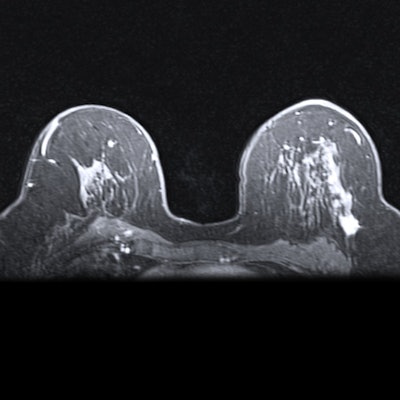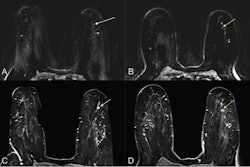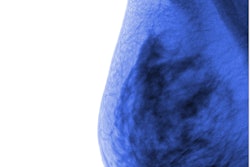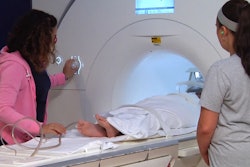
BI-RADS analysis based on a short MRI protocol plus diffusion-weighted imaging (DWI) improves diagnostic accuracy of breast cancer diagnosis and may help women avoid unnecessary biopsy, a study published February 15 in Diagnostic and Interventional Imaging suggests.
Researchers led by Dr. Audrey Milon from Assistance Publique-Hôpitaux de Paris found that their abbreviated protocol with ultrafast MRI and apparent diffusion coefficient (ADC) values from DWI had higher accuracy marks than conventional MRI.
"Ultrafast MRI sequences and diffusion-weighted sequences are useful to improve specificity and improve BI-RADS classification of breast lesions presenting with benign morphology," the team wrote.
Ultrafast MRI has been explored in supplemental breast imaging to help decrease exam time. However, fast MRI can be limited by a loss of washout criteria, which improves lesion characterization and increases specificity of breast MR images. DWI has also been explored for tumor characterization, with ADC values from such imaging yielding potential for higher specificity.
Milon and colleagues explored the efficacy of early enhancement criteria on ultrafast MRI sequencing to predict breast malignancy, as well as whether adding DWI could improve the performance of breast MRI. Two readers used BI-RADS classification based on the conventional protocol as the baseline for comparison to ultrafast MRI; they checked for the presence of early enhancement on the ultrafast sequence (30 seconds or less), as well as the presence of an ADC greater than or equal to 1.5 x 10-3 mm2/s to classify the lesions.
The study included data from 257 women with a total of 436 lesions. Of these, 157 were benign, 11 were borderline, and 268 were malignant. The researchers considered four different protocols: conventional MRI, conventional MRI plus ADC, abbreviated ultrafast MRI, and abbreviated ultrafast MRI plus ADC.
They found that the abbreviated ultrafast MRI plus ADC protocol had the highest accuracy, specificity, and positive predictive value.
| Comparison between MRI protocols in breast cancer diagnosis | ||||
| Measure | Conventional MRI protocol | Conventional MRI protocol plus ADC | Abbreviated MRI protocol with ultrafast | Abbreviated MRI protocol with ultrafast plus ADC |
| Sensitivity | 98.9% | 98.9% | 98.5% | 98.1% |
| Specificity | 28.6% | 39.3% | 42.9% | 50.0% |
| Positive predictive value | 68.8% | 72.2% | 73.3% | 75.8% |
| Negative predictive value | 94.1% | 95.6% | 94.7% | 94.4% |
| Accuracy | 71.8% | 75.9% | 77.0% | 79.6% |
The researchers attributed the high performance of the abbreviated protocols to better classification of benign lesions, which led to increased specificity.
Using early enhancement and ADC values made for high reproducibility and interreader agreement between senior and junior radiologists, they reported.
"The reproducibility and the good accuracy of less experienced readers is a crucial criterion for screening examinations," they wrote.




.fFmgij6Hin.png?auto=compress%2Cformat&fit=crop&h=100&q=70&w=100)




.fFmgij6Hin.png?auto=compress%2Cformat&fit=crop&h=167&q=70&w=250)











